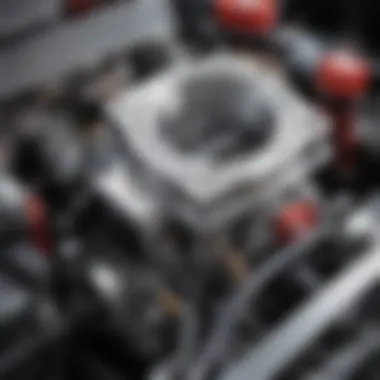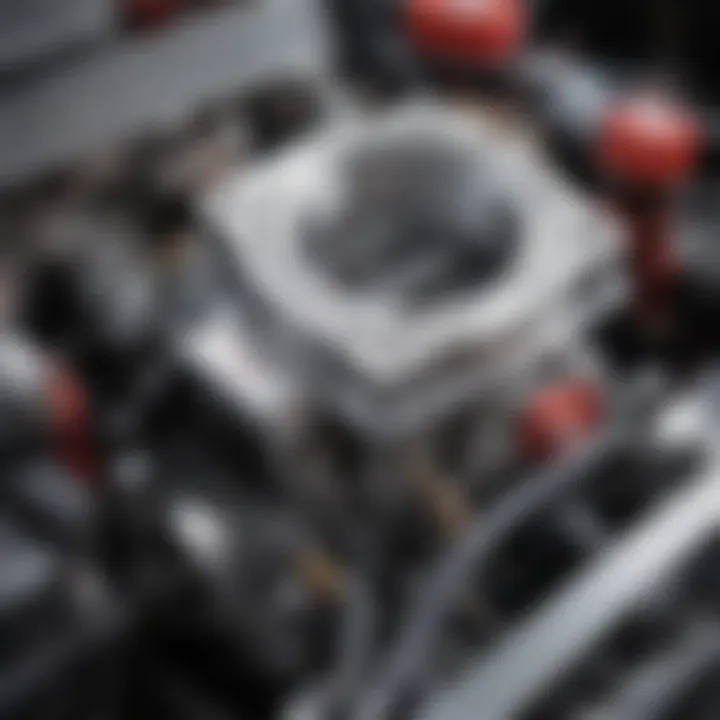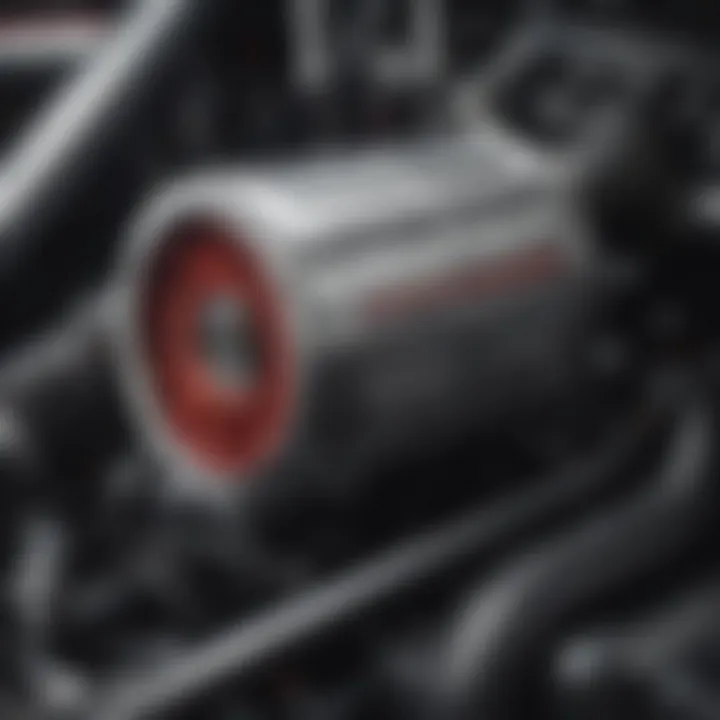Cold Air Intake Integration with Edelbrock Carburetors


Intro
Cold air intakes are often a focal point for automotive enthusiasts looking to enhance engine performance. When paired with an Edelbrock carburetor, the benefits can be pronounced, leading to improved power output and overall engine efficiency. This article aims to provide a comprehensive exploration of how cold air intakes integrate with Edelbrock carbs, examining the technology, advantages, and considerations that should be kept in mind.
The core of this discussion revolves around understanding the principles of cold air intake systems. They work by drawing cooler air into the engine, which is denser and contains more oxygen than warmer air. For a carbureted engine like one with an Edelbrock system, this can translate to better combustion and enhanced performance.
In addition to looking at the theoretical aspects, we will provide practical insights about installation, maintenance, and common challenges. For both automotive professionals and enthusiasts, knowing how to optimize your vehicle's air intake can yield significant improvements in functionality.
Let’s delve deeper into the automotive features and innovations relevant to cold air intakes and Edelbrock carburetors.
Understanding Cold Air Intake Systems
Cold air intake systems play a crucial role in optimizing engine performance. In this systematic exploration, we delve into their importance, functionality, and benefits specific to the integration with Edelbrock carburetors. Understanding these systems not only enhances knowledge but is fundamental for enthusiasts aiming for improved vehicle performance.
Functionality of Cold Air Intakes
Cold air intakes are designed to increase the amount of cool air entering the engine. Cooler air is denser than warm air, allowing for a better air-fuel mixture during combustion. This process enhances the engine's overall efficiency. The system typically comprises a filter, intake tubing, and an airbox that directs airflow to the carburetor. By allowing cooler air into the combustion chamber, these intakes ensure optimal performance when paired with Edelbrock carburetors.
Replacing a standard intake system with a cold air version can lead to tangible improvements. Enhanced airflow boosts the throttle response and energy efficiency of the engine.
Benefits for Engine Performance
Integrating a cold air intake system with an Edelbrock carburetor yields multiple advantages:
- Enhanced Power Output: Improvement in horsepower is a direct result of better airflow, leading to increased combustion efficiency.
- Improved Throttle Response: With cooler air entering the engine, responsiveness to acceleration becomes sharper. This can be especially crucial in performance driving situations.
- Increased Fuel Efficiency: A more efficient combustion process can lead to better fuel utilization, ultimately resulting in higher mpg ratings.
- Better Engine Cooling: Cooler air can help in managing engine temperatures, reducing the risk of overheating.
Overall, the functionality and benefits of cold air intake systems cannot be overstated. They represent a key component in modern automotive performance upgrades, particularly when paired with the renowned capabilities of Edelbrock carburetors.
"Understanding cold air intake systems is essential for those who wish to maximize engine performance while maintaining optimal driving conditions."
These factors make it necessary for automotive enthusiasts to consider cold air intakes seriously when aiming for performance enhancements.
Overview of Edelbrock Carburetors
Edelbrock carburetors hold a significant place in the automotive world, particularly among enthusiasts who seek to optimize engine performance. Understanding these carburetors is crucial, as they offer unique features that enhance fuel management, combustion efficiency, and overall power output. This overview will explore their specific characteristics and how they interact with cold air intake systems, influencing performance.
Features of Edelbrock Carburetors
Edelbrock carburetors are known for their innovative design and reliable performance. Here are some of their standout features:
- High-Quality Materials: Constructed from durable materials, these carburetors endure harsh conditions, offering longevity.
- Easy Tuning: The design allows for simple adjustments of air-fuel mixtures, making it accessible for both novice and experienced users.
- Variety: Available in multiple models tailored for different engine sizes and configurations, they cater to a wide range of vehicles.
- Enhanced Throttle Response: Improved airflow dynamics ensure faster throttle response, contributing to better acceleration and performance.
- Performance Testing: Edelbrock carburetors are rigorously tested, ensuring they meet the high standards required for serious automotive applications.
These features make Edelbrock carburetors a preferred choice for car enthusiasts aiming to boost their vehicle's performance.
Compatibility with Cold Air Intakes
Integrating a cold air intake system with an Edelbrock carburetor can lead to substantial improvements in engine efficiency and power. Cold air intake systems enhance the amount of cold air entering the engine, resulting in better combustion when paired with an efficient carburetor.
Consider the following compatibility aspects:
- Airflow Optimization: Both systems are designed to maximize airflow. This synergy ensures that the engine efficiently draws in the cold air, which is essential for maintaining an optimal air-fuel ratio.
- Eclectic Performance: Engine performance, particularly in terms of horsepower and torque, is significantly benefited when these systems work together.
- Installation Considerations: When fitting cold air intakes with Edelbrock carburetors, it’s crucial to consider the available space and the specific model of the carburetor to ensure a proper fit and functionality.
- Enhancements with Adjustments: Minor tuning adjustments may be required in the carburetors to fully leverage the benefits of the cold air intake, focusing on the precise air-fuel mixture necessary for peak performance.
A thoughtful installation of a cold air intake system to complement an Edelbrock carburetor can ultimately result in enhanced engine performance and reliability.
Key Considerations Before Installation
When contemplating the installation of a cold air intake system connected to an Edelbrock carburetor, there are numerous elements to consider. This section will explore the essential aspects that can contribute to both the installation's success and the overall performance of your vehicle. Carefully evaluating these factors will lead to a more satisfying automotive experience.
Assessing Vehicle Requirements
Before proceeding, it is crucial to assess your vehicle's specific requirements. Not every cold air intake system suits all vehicles. Consideration should be given to the engine size, type of modifications already installed, and the vehicle's intended use. This includes whether the vehicle is used for daily driving, performance racing, or off-road activities.


A mismatch between a cold air intake and the vehicle can lead to poor performance or even damage in some cases. For instance, a system designed for a high-performance application may not be suitable for a vehicle that primarily sees street use. Understanding your engine's airflow needs can guide you towards a relevant product.
One common method is to consult your vehicle's manual or specifications online. This process helps ensure the selected parts align with your goals and setup.
Selecting the Right Cold Air Intake
Once you have assessed your vehicle’s requirements, the next step involves selecting the appropriate cold air intake system. This step influences not only performance but also ease of installation and maintenance.
Several factors should be reviewed:
- Material: Cold air intakes come in different materials such as plastic, metal, or rubber. Each has its own pros and cons. For example, plastic intakes may provide better heat insulation compared to metal ones, which can retain heat and potentially decrease performance.
- Design: The design of the intake is significant. Some systems may offer better airflow dynamics than others.
- Brand Reputation: Choose a reputable brand that is known for high-quality products. Brands with strong customer feedback often give better performance reliability.
- Filter Type: The filter affects not only the airflow but also how often you will need maintenance. Consider whether you want a washable filter or a disposable one.
Remember:
"Choosing the right cold air intake is a crucial decision that directly impacts vehicle performance."
In summary, both assessing your vehicle's requirements and selecting the right cold air intake are fundamental steps before installation. Taking these factors into account will help ensure a successful integration that enhances your automotive experience.
Installation Process of Cold Air Intake with Edelbrock Carb
The process of installing a cold air intake with an Edelbrock carburetor is vital for performance enthusiasts looking to enhance their vehicle's efficiency and power. Cold air intakes are engineered to provide an optimal air-fuel mixture, improving engine performance while sustaining reliability. This section will highlight the essential aspects of the installation process, detailing important tools, step-by-step instructions, and troubleshooting tips.
Essential Tools Required
Before beginning the installation, it is critical to gather the right tools. Having the appropriate equipment on hand ensures a smoother process and minimizes potential issues. The following tools are typically necessary:
- Socket Set: This is fundamental for loosening or tightening bolts securing the intake and carburetor.
- Wrenches: Useful for adapting to various sizes of fasteners.
- Screwdrivers: Flathead and Phillips screwdrivers are required for various clamps and fittings.
- Air Filter Cleaner: Maintenance of the intake system often includes cleaning, so this item is essential.
- Pliers: Handy for managing hose clamps and other components.
- Torque Wrench: Ensures bolts are tightened to the manufacturers specified specifications.
Having these tools available will save time and increase efficiency during the installation.
Step-by-Step Installation Guide
To effectively install a cold air intake with an Edelbrock carburetor, follow these detailed steps:
- Preparation: Before starting, park the vehicle on a flat surface and ensure the engine is cool. Disconnect the battery to eliminate electrical risks.
- Remove the Old Air Intake: Begin by detaching the existing air intake system. Loosen the clamps and unscrew the fasteners. Carefully lift off the intake and remove any associated hardware.
- Inspect the Carburetor: Ensure the Edelbrock carburetor is clean and in good working condition. Replace if any damages are found.
- Position the New Cold Air Intake: Align the new cold air intake system with the carburetor. Make sure it fits snugly and is positioned correctly to avoid any bending of pipes.
- Secure the Intake: Once positioned, utilize the socket set and wrenches to fasten the intake system securely. Ensure there are no gaps that might allow unfiltered air to enter.
- Connect Hoses and Clamps: Attach the necessary hoses and clamps that connect to the air filter and carburetor.
- Check for Leaks: After everything is in place, double-check all clamps and connections for tightness.
- Reattach the Battery: Once satisfied, reconnect the battery.
- Test Run: Start the engine and run it briefly to inspect the intake system functionality and listen for unusual sounds.
This thorough guide minimizes disruption during installation and sets the foundation for effective engine performance.
Troubleshooting Common Installation Issues
Even with careful installation, challenges can occur. Here are common issues along with their solutions:
- Poor Fitment: If the cold air intake does not fit properly, check for any misalignment or incompatible components. Adjust or replace as needed.
- Vacuum Leaks: Unsecured hoses or clamps may lead to vacuum leaks. Inspect all connections for tightness and re-secure them if needed.
- Engine Check Light Activation: Sometimes, the engine may run fine but trigger a warning light. Verify all electronic connections to ensure they are rightly connected.
- Unusual Engine Sounds: This could indicate improper installation. Listen for any air sucking noises that may suggest a loose connection or gap.
- Decreased Performance: If performance drops, revisit the installation steps to ensure everything has been correctly positioned and secured.
By knowing how to troubleshoot these common problems, enthusiasts can ensure their installation is as straightforward and efficient as possible.
"Regular maintenance and a correct installation can drastically improve the performance of your vehicle while protecting the engine’s longevity."
Performance Enhancements with Cold Air Intakes
The integration of a cold air intake system into your vehicle's setup is not a trivial matter. It holds significant implications for performance. In this section, we will delve into two vital aspects: fuel efficiency improvements and acceleration and power gains. Both elements contribute to an optimized driving experience, especially for those equipped with Edelbrock carburetors.
Fuel Efficiency Improvements
Enhancing fuel efficiency is a core advantage of installing a cold air intake system. The design of these systems allows for a higher volume of cooler air to enter the engine. This is essential since cooler air is denser than warm air, allowing for improved combustion efficiency. The relationship between air density and engine performance is crucial.
A more efficient combustion process leads to better fuel economy, translating to a longer driving range on a tank of gas. For car owners focused on both performance and practicality, this improvement can seem appealing. Here are some key points about this correlation:
- Increased Air Volume: A cold air intake delivers more air compared to factory systems, ensuring that the engine receives optimal oxygen.
- Enhanced Combustion: With better air-fuel mixing, the engine runs more efficiently, yielding more power with less fuel consumed.
- Potential Cost Savings: Over time, the improvement in fuel consumption can offset the initial investment of the cold air intake system.
"The right cold air intake can improve fuel efficiency by up to 10%. That’s a significant figure over time."
Acceleration and Power Gains


Acceleration and power gains represent another compelling argument for the implementation of a cold air intake with an Edelbrock carburetor. When the engine is supplied with a higher volume of cooler air, it can operate more effectively, translating directly to increased horsepower and torque. It is clear that the relationship between these factors is beneficial for performance-focused drivers.
Drivers aiming for better acceleration will appreciate the following benefits:
- Immediate Response: A well-designed cold air intake system allows the engine to respond better when the accelerator is pressed. This is a game-changer in race scenarios or impulse driving situations.
- Measured Power Improvements: Reports from users indicate that installing a cold air intake has resulted in noticeable horsepower increases, often in the range of 5-15%. This is significant for both street driving and competitive scenarios.
- Dynamic Engine Performance: Improved airflow contributes to a more responsive throttle, allowing for a satisfying driving experience.
Maintenance Practices for Cold Air Intakes
Maintaining a cold air intake system is crucial for ensuring that it operates effectively over time. Regular upkeep not only prolongs the lifespan of the intake but also sustains optimal engine performance. When a cold air intake is well-maintained, it can effectively deliver cooler, denser air to the engine, leading to improvements in power and efficiency.
Routine Inspections
Routine inspections should be a staple in any car owner's maintenance schedule. Checking the cold air intake regularly helps identify potential issues before they escalate. During an inspection, owners should look for:
- Physical Damage: Inspect the intake piping for cracks or other signs of wear.
- Improper Seals: Ensure that all connections are tight and there's no air escaping.
- Debris Accumulation: Check for leaves, dirt, or other items lodged in or around the intake system.
A thorough assessment helps maintain airflow efficiency. If the intake becomes damaged or blocked, it can significantly hinder engine performance. Keeping an organized log of inspections can also help track the system's condition over time.
Cleaning Techniques for Air Filters
Air filters are the heart of any intake system. They prevent dirt and debris from entering the engine. However, over time, these filters can become clogged, negating the benefits of a cold air intake. There are two primary types of air filters typically used:
- Reusable Filters: These filters can be cleaned and reused. It's essential to gently wash them with a proper cleaner and dry them completely before reinstalling.
- Disposable Filters: These filters are designed for single use. When they become dirty, replacement is necessary.
Cleaning or replacing air filters according to the manufacturer's guidelines is vital. Not performing regular cleanings can lead to restricted airflow and decreased performance. Owners should also consider the environment in which the vehicle operates. Dusty or dirty areas may necessitate more frequent cleanings.
"A clean intake system is essential for optimal engine performance. Neglecting it can lead to costly engine repairs."
In summary, establishing regular maintenance practices for cold air intakes enhances vehicle performance. By performing sufficient inspections and maintaining air filters, car enthusiasts can ensure that their systems remain in top shape.
Impact of Cold Air Intake on Engine Life
Integrating a cold air intake system with an Edelbrock carburetor can significantly affect the longevity and overall life of an engine. Understanding this impact is crucial for automotive enthusiasts and car owners who seek to enhance both performance and durability. Cold air intakes are designed to improve airflow, which can lead to more efficient combustion. This efficiency not only boosts power but also plays a pivotal role in reducing strain on the engine components, thus contributing to a longer engine life.
Understanding Engine Dynamics
To grasp how cold air intakes affect engine life, it is important to have a clear understanding of engine dynamics. The engine operates based on an air-fuel mixture, which needs to be optimal for efficient combustion. A cold air intake delivers denser, cooler air to the combustion chamber, allowing for a better air-fuel ratio. This improved mixture results in a more complete burn during combustion. A more efficient combustion process minimizes the production of carbon deposits and engine knocking, both of which can lead to greater wear over time.
Additionally, when cooler air enters the combustion chamber, it helps maintain lower operating temperatures. Elevated temperatures can accelerate wear on various engine components, particularly gaskets and seals. By delivering cooler air, cold air intakes contribute to stabilizing the operating temperature, thus minimizing thermal stress on the engine.
Minimizing Wear and Tear
Wear and tear are inevitable in any engine but can be mitigated through appropriate modifications like installing a cold air intake. One of the primary benefits lies in reducing the workload on the engine. With improved airflow and optimal combustion, the engine does not have to exert as much effort to perform its functions. This results in less friction among moving parts, which is a common cause of engine degradation over time.
Moreover, cold air intakes often come with high-quality filtration systems. These filters are designed to capture more particulate matter and impurities from the air before they enter the engine. By preventing contaminants from circulating within the engine, these filters enhance the cleanliness of internal components, which directly influences the engine's lifespan.
In summary, the impact of a cold air intake on engine life is multifaceted. From facilitating improved combustion and maintaining cooler operating temperatures to reducing wear and filtering contaminants, cold air intakes offer clear advantages. When combined with an Edelbrock carburetor, these systems not only boost performance but also support the long-term health of the engine.
Evaluating Aftermarket Options
When considering a cold air intake system for an Edelbrock carburetor, evaluating aftermarket options becomes a critical part of the process. The marketplace offers a variety of products from different brands, and each presents unique benefits and potential drawbacks. Understanding these elements is essential for car enthusiasts and owners who wish to optimize both performance and efficiency.
Comparative Analysis of Brands
Multiple brands manufacture cold air intake systems suitable for use with Edelbrock carburetors. Among the most notable are K&N, Spectre, and Airaid. Each brand utilizes distinct design strategies and materials which can impact performance:
- K&N: Known for high airflow and filtration capabilities, K&N's systems often feature reusable filters that can enhance long-term cost-effectiveness.
- Spectre: Offers cost-friendly options which usually focus on aesthetics while trying to improve airflow.
- Airaid: Prioritizes ease of installation and high-quality materials, providing options that frequently come with a lifetime warranty.
When selecting a brand, it is essential to consider compatibility with the specific model of the Edelbrock carburetor as well as personal performance goals.
Cost-Benefit Considerations
The initial price point of cold air intake systems can vary significantly. However, a higher cost does not always guarantee better performance. Factors to examine include:


- Performance Gains: Analyze potential horsepower or torque increases against the purchase price. A moderately priced option that offers significant performance gains may be more advantageous than a premium priced product with negligible improvements.
- Durability and Maintenance: Some brands promote better durability and require less frequent maintenance. A system that lasts longer without requiring replacements can justify a higher upfront cost.
- Installation Fees: Consider whether you will install the system yourself or hire a professional. Some systems are designed for easy installation, reducing additional costs.
"Evaluating aftermarket options carefully leads to informed decisions that enhance vehicle performance without unnecessary expenditures."
An intelligent approach to evaluating these elements solidifies the foundation for making the best choice regarding cold air intakes for an Edelbrock carburetor. Proper research and analysis will ensure a suitable match that meets the performance requirements while remaining cost-effective.
Real-World User Experiences
Real-world user experiences provide valuable insights into the practical implications of integrating a cold air intake system with an Edelbrock carburetor. These experiences are crucial because they bridge the gap between theoretical expectations and actual performance in everyday driving scenarios. Enthusiasts and professionals alike benefit from understanding how these systems function in the field, as they reveal both the advantages and potential challenges faced by users.
Case Studies of Car Enthusiasts
Case studies involving car enthusiasts serve as practical examples of how cold air intakes influence performance with Edelbrock carburetors. One notable case involves a 1967 Chevrolet Camaro. The owner installed a cold air intake and reported noticeable improvements in both throttle response and fuel efficiency. Data from dyno testing showed an increase of approximately 10 horsepower, which the owner attributed to better airflow provided by the intake system.
Another example is a Ford Mustang equipped with an Edelbrock carburetor. The user detailed their experience of smoother acceleration and improved high-end power delivery after the installation of a cold air intake setup. This user linked the enhancements directly to the cooler, denser air intake generated by the system, which helped optimize engine performance. These examples highlight how user modifications can yield significant performance benefits when paired properly.
By gathering feedback from various enthusiasts, it becomes clear that performace gains lead many to use cold air intakes. However, it’s essential to remember that experiences can vary widely based on vehicle configuration, driving conditions, and the specific parts used.
Expert Opinions and Recommendations
Expert opinions also play a vital role in shaping user expectations regarding cold air intakes paired with Edelbrock carburetors. Experts, ranging from automotive engineers to professional tuners, all emphasize the importance of proper installation and selection of compatible components. Many recommend brands like Spectre Performance and K&N for their quality and proven track records.
Experts frequently advise against overly generic setups, as they may not provide optimal airflow for specific engine configurations.
Additionally, professionals encourage users to consider their specific performance goals when selecting a cold air intake. "It's essential to match the intake design with your intended applications, whether that's daily driving or high-performance racing," says a prominent automotive engineer. This tailored approach not only enhances performance but also maintains engine longevity.
Furthermore, professionals suggest routine maintenance checks to ensure the system remains free of debris and maintains its efficiency. Proper filtering and cleanliness can exacerbate or mitigate the gains made by a cold air intake system. Therefore, ongoing attention to performance and upkeep becomes a recurring theme in expert recommendations.
Ultimately, real-world user experiences, combined with expert insights, help to form a comprehensive understanding of the lifecycle and impact of cold air intake systems on engines with Edelbrock carburetors.
Environmental Considerations
Understanding the environmental implications of automotive upgrades is crucial in today's context of rising ecological awareness. This section focuses on how integrating a cold air intake system with an Edelbrock carburetor can contribute to better emissions performance and overall engine efficiency. Car enthusiasts often overlook these aspects, yet they are vital for sustainable driving practices.
Emissions and Engine Efficiency
Emissions from vehicles directly affect air quality and contribute to climate change. Cold air intake systems can enhance engine performance by increasing air density. This process allows for more complete combustion of fuel, which minimizes the release of unburned hydrocarbons. Improved air flow means your engine can operate more efficiently.
- Fuel Combustion: A cold air intake introduces cooler air, promoting better fuel combustion. This translates into lower emissions due to less unburned fuel escaping.
- Gas Mileage: Enhanced combustion efficiency can also lead to improved gas mileage. A well-tuned engine that runs efficiently burns less fuel, leading to reduced emissions over time.
- Monitoring Emissions: It is important to be aware of local regulations regarding emissions. Upgrading to a cold air intake may affect your vehicle's status unless it is calibrated correctly. Make sure to do the necessary checks.
"A cold air intake can change how your car breathes, influencing the overall impact it has on its surrounding environment."
Sustainability in Automotive Upgrades
The move towards sustainability is not just a fad but a necessary trend in the automotive industry. Choosing components like a cold air intake for Edelbrock carburetors can be a step toward more responsible car ownership.
- Material Choices: Many aftermarket cold air intakes are made from materials that are recyclable, reducing what goes to waste after the product's lifecycle.
- Efficiency Over Time: A cold air intake not only aids in performance but also contributes to longevity by ensuring the engine's optimal functionality. A well-maintained engine lasts longer, reducing the frequency at which new vehicles need to be manufactured, thus lowering overall resource consumption.
- Aftermarket Innovations: The automotive market is evolving towards more environmentally friendly solutions. It is worthwhile to research brands that prioritize sustainable manufacturing practices.
By considering these elements, automotive enthusiasts can make informed decisions that help both their vehicle’s performance and the environment. Understanding the environmental impact of upgrades not only serves the individual car owner but contributes to a broader cause of sustainable transportation.
Future Trends in Engine Air Intake Systems
The automotive landscape is undergoing significant transformation, particularly regarding engine air intake systems. As car manufacturers and consumers become more aware of environmental concerns and performance optimization, the future trends in air intake systems are essential to understand. These advancements are closely tied to regulatory changes, technological innovations, and shifting consumer preferences. By exploring these trends, automotive enthusiasts and professionals can prepare for the shifts in the industry and stay informed about the latest developments that may affect their vehicles, especially those utilizing Edelbrock carburetors.
Technological Innovations
Advancements in technology play a crucial role in the evolution of engine air intake systems. Modern air intake systems are increasingly incorporating features that improve performance and ensure compatibility with a growing range of engine types.
- Smart Sensors: Innovations like intelligent sensors are becoming common in air intake systems to optimize air flow based on real-time engine conditions. These sensors can help manage air density, ensuring the engine receives the most efficient air mixture for combustion.
- Advanced Materials: The introduction of lightweight and durable materials like carbon fiber allows for better airflow and reduced weight. These changes lead to improved fuel efficiency and enhanced engine performance.
- Performance Tuners: The rise of software tuners enables users to adjust air intake parameters. This makes it easier for car enthusiasts to customize their intake systems for enhanced performance tailored to specific needs.
The combination of these innovations allows for greater adaptability and efficiency in air intake systems, which benefit not just performance but also longevity of engine components.
The Shift Towards Electrification
As the automotive industry shifts toward electrified vehicles, air intake systems are also evolving. This transition is reshaping traditional notions of engine performance and efficiency.
- Hybrid Systems: With hybrid vehicles, the balance between electric and internal combustion engines requires unique air intake strategies. This trend will push manufacturers to develop systems that optimize performance regardless of the power source.
- Electric Vehicles (EVs): In fully electric vehicles, traditional air intake systems become less relevant, but improvements in battery cooling and air management systems are becoming crucial. Engineers focus on enhanced thermal management, as efficient cooling is essential for battery lifespan and performance.
- Integration of AI Technologies: The application of artificial intelligence in managing air intake systems represents a future trend. AI can analyze vast data sets from vehicle performance to optimize intake on-the-fly, improving both efficiency and performance.
The evolution of air intake systems will likely continue to provide significant opportunities for performance enhancements and efficiencies, particularly within the realm of Edelbrock carburetors.







